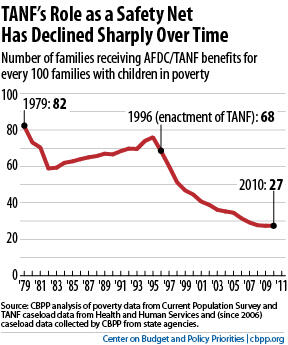off the charts
POLICY INSIGHT
BEYOND THE NUMBERS
BEYOND THE NUMBERS
An op-ed in today’s Wall Street Journal sings the praises of the Temporary Assistance for Needy Families (TANF) block grant, claiming it shows that block-granting Medicaid would enable states to operate better programs for less money. The facts show otherwise: TANF provides a significantly weaker safety net than the program it replaced, and states have used their flexibility under the block grant not to strengthen TANF but instead to shift funds elsewhere in their budgets.
- TANF helps many fewer poor families than in 1996. In 1996, for every 100 families with children living in poverty, TANF provided cash aid to 68 families. By 2010, this figure had plummeted to 27. This weakening of the safety net is a key reason why the number of children in families living on $2 per person per day — one World Bank definition of poverty for developing nations — doubled between 1996 and 2011, from 1.4 million to 2.8 million.
Image

- States have used TANF funds to pay for a broad range of services, including some that Congress didn’t envision when it created the block grant. In 2011, states spent just 29 percent of their TANF block grant to provide basic assistance to poor families, down from 70 percent in 1997. States used their flexibility to shift TANF funds to cover a broad range of services, including some that they had paid for with state funds or would have paid for with state funds if TANF funds were not available.
- States did not respond to higher need during hard economic times. The Great Recession provided the ultimate test of whether states could do a better job than the federal government of providing a safety net for poor families. They failed. While the number of unemployed Americans doubled during the downturn, the number of TANF recipients rose by just 13 percent and caseloads in 22 states rose little or not at all. When the need for cash assistance rose during the recession, states responded by scaling back their TANF programs to save money — shortening and otherwise tightening time limits and further cutting already low benefit levels, leaving the poorest families poorer.
Stay up to date
Receive the latest news and reports from the Center
